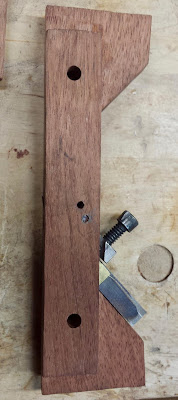The body is glued up now.
I'm something up the ribs and the edges of the belly and the back. I glued on the neck extension, and trimmed it down flat on the top, and even to the rest of the neck on the sides. It's starting to look finished.
I have an idea for edge work on it. Something a bit older than you would find on a normal arch top. I figure that old man Guadagnini might want to show a bit of his flair. Since he put f holes no it, and not the round sound hole that could be embellished with a rose in the hole, or fancy inlays around the hole, he would have to put his make elsewhere.
Why not the outline.
It was already being done. I have the plans for a guitar that is VERY ornate, and has a geometric pattern around the edge. I'm thinking outside of that, but in that line of thinking. I'll have to try it out full scale in the proper woods before I start slicing up the guitar to do it. I have marked it out, and it looks good proportionally.
It seems I went overboard on the neck extension, and the neck dovetail. It FOR SURE isn't coming loose! I've been looking, leaning, and posting on the Official Luthiers Forum for a while, and they have a very active post on how not to do stupid things that would make repairs hard. My neck is one they could write about.
The dovetail is tapered both smaller and deeper. It is glued the entire length; even on the back face, the face of the upper block, and the button on the back. THEN the extension is fit into a cut into the neck end at a 45 degree angle or so, and glued to both the neck, and the upper block.
Yeah, that thing is solid.
I could have left the back of the dovetail deep, like they recommended, but I was thinking that the fit was so good, and the joint so long, and solid, gluing at the button, and a couple of wood screw to keep it from wanting to move would be sufficient. The joint at the top with the extension would prevent it form coming loose.
It would be the same, but with less glue on the dovetail. Oh well.
For the binding I'm just going to use .5 mm thick, black dyed wood veneer that I have laying around. I'd better check to be sure that I have enough. I can mark the depth I'm going down with a scribe, and file it .5 mm deep. My plan calls for a black purfling line defining the inlay area around the edge too, so I'll do that at the same time. Then the inlay.
I have the fretboard roughed out. It is still rectangular, but has a conical (12 inch, to 17.5 inch) radius cut on it. I'll cut the slots for the frets in it, rough the angle on the side, and glue it in place.
The photo doesn't show it that well, but the lower treble wing has decided to raise up. It has a mind of its own.
With the truss rod, and the 6 Grover Ukulele tuners (they only weigh 80 grams) it weighs 1420 grams. With the fretboard and frets, it might be around 1600 grams. My classical hanging on the wall is a little over 1800 grams, so it is fairly light.
But first we have to get a mock up of the inlay around the edge done so we can be sure that it works. It looks cool in my head.
I wonder if nylon strings will drive it, or if it will need a 30% jump in tension to light steel strings. We have a ways to go to find that out. I can push it down at the bridge, but it takes some effort.























